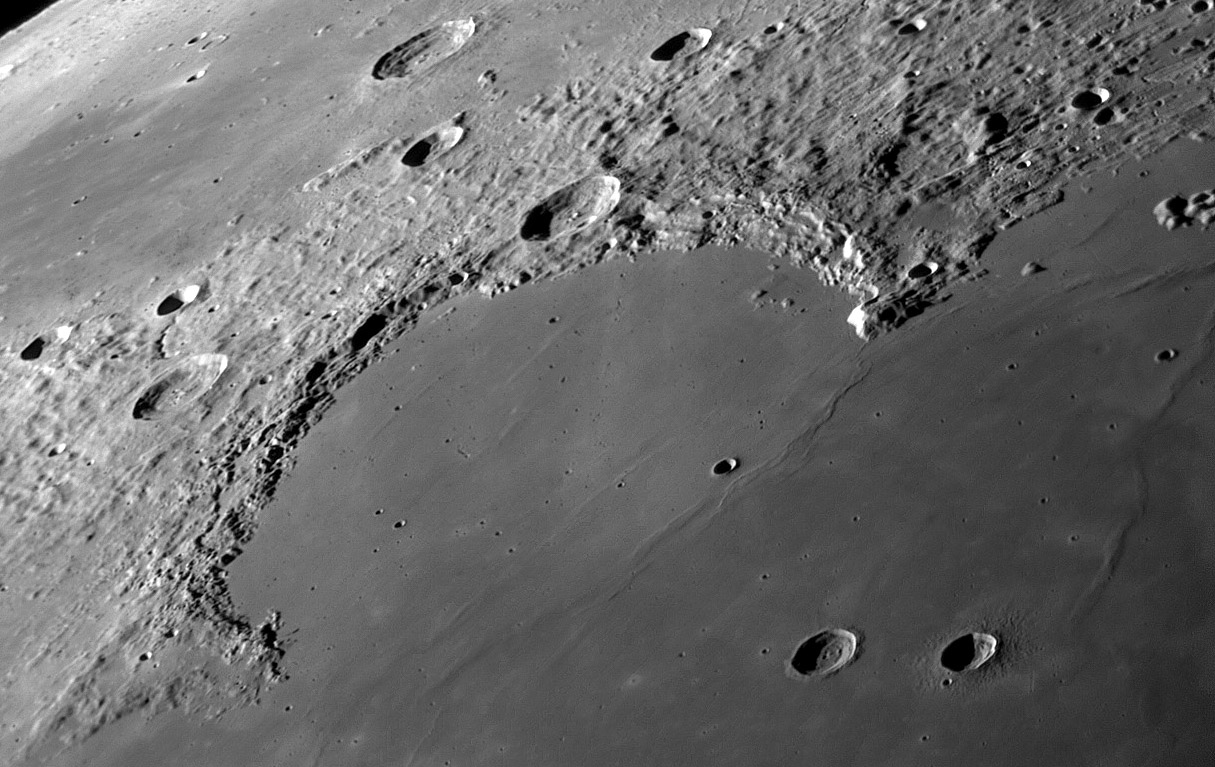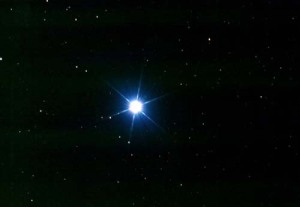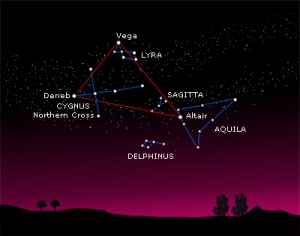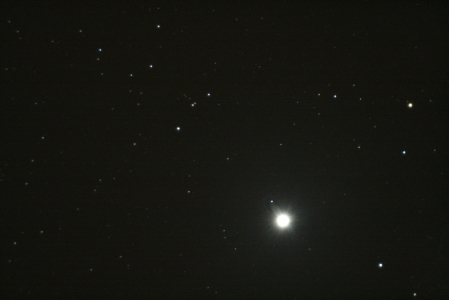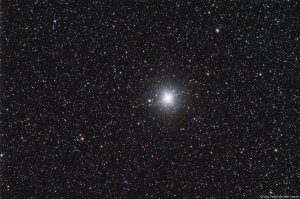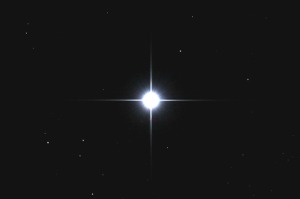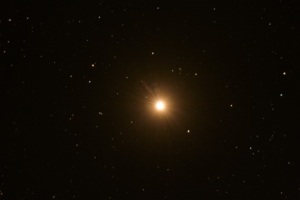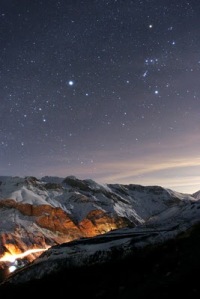The Great Bear
Posted by: bitacoradegalileo on: August 27, 2011
DESCRIPTION
This is a beautiful constellation, the most famous in the Northern Hemisphere, and also the best reference to find the North Star, we will see the appropriate method for this.  It is a circumpolar constellation, therefore visible during the entire year, even at latitudes near 20 ° S, and even more southern, as Argentina’s northern border with Bolivia and the Chilean regions of Tarapaca and Antofagasta. Boreal dwellers, as stated above, we have vision at any time of year.
It is a circumpolar constellation, therefore visible during the entire year, even at latitudes near 20 ° S, and even more southern, as Argentina’s northern border with Bolivia and the Chilean regions of Tarapaca and Antofagasta. Boreal dwellers, as stated above, we have vision at any time of year.
Its asterism (the set of stars that seem to form a shape characteristic of each constellation) is undoubtedly the most famous, and its shape makes it known by various names such as Plough or Big Dipper  although the stars that are reminiscent of these shapes are only part of the constellation, albeit they are the most visible to the naked vision due to their size. The main stars of the Dipper, except Dubhe and Benetnash, have a common proper motion, and constitute what is called Ursa Major Moving Group.
although the stars that are reminiscent of these shapes are only part of the constellation, albeit they are the most visible to the naked vision due to their size. The main stars of the Dipper, except Dubhe and Benetnash, have a common proper motion, and constitute what is called Ursa Major Moving Group.
Ursa Major, is surrounded by Lynx, Bootes (Arcturus) and Dragon, among other constellations.
- The Big Dipper, photographed from Kahului, Hawaii, 19 degrees North latitude.
MAIN STARS
Here we find three first-magnitude stars (Alioth, Dubhe, and Benetnash or Alkaid), and three second-magnitude (Mizar, Merak and Phekda), plus Megrez, of third magnitude which are the seven that make up the asterism of the Plough.
We will stop briefly at each one, from right to left, according to their Bayer designation (the Greek letter that precedes the Latin genitive of the constellation):
 Dubhe (Alpha Ursae Majoris), which we see in the picture on the right, is a multiple star system that is 124 light years from us. With +1.8, is the second brightest star in the constellation after Alioth.
Dubhe (Alpha Ursae Majoris), which we see in the picture on the right, is a multiple star system that is 124 light years from us. With +1.8, is the second brightest star in the constellation after Alioth.
Merak (Beta UMa) has a magnitude of +2.34 and is just the fifth brightest. It will be important, along with Dubhe, as it helps us find the North Star.
Gamma UMa is Phekda, a white star situated 84 light years away and with a magnitude of +2.4.
Megrez (Delta UMa) is, with magnitude +3.32, the weakest of the seven that form The Plough.
To the left as we observe a photography of Alioth (Epsilon Ursae Maioris), wich is the most luminous in the constellation, with a magnitude of +1.76. It’s located at about 82 light-years of distance and it is a white star, slightly variable.
Mizar (Zeta UMa) is a very peculiar double star, known because it poses an acid test for visual acuity,
 since those who enjoy this advantage can separate it at a glance from its companion, Alcor (80 UMa, doesn’t have a Bayer designation). I am not among the lucky ones, although it is the mother of my children, that perfectly describes the situation of both in a direct observation. If you turn turn your attention to the photos above again, now that you know the location of Mizar, you may perceiving this circumstance.
since those who enjoy this advantage can separate it at a glance from its companion, Alcor (80 UMa, doesn’t have a Bayer designation). I am not among the lucky ones, although it is the mother of my children, that perfectly describes the situation of both in a direct observation. If you turn turn your attention to the photos above again, now that you know the location of Mizar, you may perceiving this circumstance.
Benetnash or Alkaid (Eta Ursae Majoris), lastly, is a blue-white star of +1.85 in magnitude, the third brightest of the Great Bear.
THE GREAT BEAR AND THE NORTH STAR
The two stars opposing the handle of the Dipper, ie, Dubhe and Merak, will help us to find  the North Star very easily. Effectively, extending the line joining the two stars towards Dubhe, the brighter of the two, about five times, we get to Polaris without difficulty. This resource will be useful for excursionists who are disoriented at night, easily providing the situation of the North.
the North Star very easily. Effectively, extending the line joining the two stars towards Dubhe, the brighter of the two, about five times, we get to Polaris without difficulty. This resource will be useful for excursionists who are disoriented at night, easily providing the situation of the North.
 This star chart is nothing new. It’s reproduced on the state flag of Alaska in the United States of America. The high latitude of this country justifies the presence of the Great Bear below, whose stars pointers indicate the position of Polaris, top right, on the blue background that symbolizes the northern sky.
This star chart is nothing new. It’s reproduced on the state flag of Alaska in the United States of America. The high latitude of this country justifies the presence of the Great Bear below, whose stars pointers indicate the position of Polaris, top right, on the blue background that symbolizes the northern sky.
On the other hand, the Polar Star On the other hand, the Polar Star is a center of radial symmetry between the Great Bear and the constellation Cassiopeia, that in the figure we observe has the shape of a “W” or an “M” and both will forever be at opposite situations with respect to the North Celestial Pole, represented by
On the other hand, the Polar Star is a center of radial symmetry between the Great Bear and the constellation Cassiopeia, that in the figure we observe has the shape of a “W” or an “M” and both will forever be at opposite situations with respect to the North Celestial Pole, represented by
Polaris, the pivot around which they revolve counterclockwise.
MAIN DEEP SKY OBJECTS
In the constellation of Ursa Major we find more than fifty of these objects, among which we have galaxies, nebulae and star clusters. So we limit ourselves to four of them, the best known, all members of Charles Messier’s Catalog.
 Bode’s Galaxy (M81), in the picture with the smaller Cigar Galaxy (M82) is a spiral galaxy distant from us in about 12 million light-years. It contains about 250,000 stars and can be seen with binoculars. Its companion, M82, is also a spiral but we see its edge, so that its elongated aspect resembles a cigar.
Bode’s Galaxy (M81), in the picture with the smaller Cigar Galaxy (M82) is a spiral galaxy distant from us in about 12 million light-years. It contains about 250,000 stars and can be seen with binoculars. Its companion, M82, is also a spiral but we see its edge, so that its elongated aspect resembles a cigar.
The Pinwheel Galaxy (M101) is around 27 million light-years afar from our Solar System. Is a barred spiral with obvious asymmetry because of its off-center core of the disc. It is one of the most prominent spirals in heaven, and can also be seen with binoculars if the conditions of darkness and clean air are conducive to observation.
Is a barred spiral with obvious asymmetry because of its off-center core of the disc. It is one of the most prominent spirals in heaven, and can also be seen with binoculars if the conditions of darkness and clean air are conducive to observation.
Finally, the Owl Nebula ( M97 ), gets its name for having two dark spots  on the gaseous disk of the nebula, which resemble the eyes of this animal. It is a planetary nebula and we still do not know well its distance, though there are different estimations of about 2,600 light-years.
on the gaseous disk of the nebula, which resemble the eyes of this animal. It is a planetary nebula and we still do not know well its distance, though there are different estimations of about 2,600 light-years.
HISTORY
 This constellation is identified with the Great Bear from the time of Homer, who already quoted it in his major works, The Iliad and The Odyssey calling it Bear and Cart. In Higinio we read one of the most popular names of the Great Bear, Triones, ie oxen. As there are seven brightest stars of the asterism, it was customary precede seven to the name, hence septem triones (seven oxen) or septentrion, name that received the northerly wind.
This constellation is identified with the Great Bear from the time of Homer, who already quoted it in his major works, The Iliad and The Odyssey calling it Bear and Cart. In Higinio we read one of the most popular names of the Great Bear, Triones, ie oxen. As there are seven brightest stars of the asterism, it was customary precede seven to the name, hence septem triones (seven oxen) or septentrion, name that received the northerly wind.
Different cultures have associated the constellation figure from Siberian Yakut to diverse North American Indian tribes, including Iroquois. It also appears in Pyrenean myths and in northern regions. It can be recognized easily in Egyptian texts, along with Orion and Sirius. It currently receives the names of The Plough in European countries, and The Big Dipper in America.
THE MITH
The great Zeus fell madly in love with Callisto, the beautiful huntress nymph inhabitant of the forests of Arcadia. The father of the gods seduced the nymph, and she became pregnant. Upon learning what happened Hera, wife of Zeus, prey of jealousy, turned Calisto into a bear.
Over time, Arkas, the son of Calisto, also a hunter, one day came across a bear and wanted to kill it, not knowing it was his mother. Zeus intervened and revealed the truth. For that not to happen again, Zeus took Callisto, turned into a bear, from her tail and threw her into the sky, also transformed Arkas into a bear and put him in heaven with her mother to keep her company. Arkas is the constellation of Ursa Minor (the Little Bear).
But Hera, wife of Zeus, was not happy and asked her brother, Poseidon, to not allow the heavenly bears, Calisto and Arkas, to approach to his marine domains. Then, The Great Bear and the Little Bear never disappear beneath the sea.
Sinus Iridum and the Moon Maiden
Posted by: bitacoradegalileo on: July 27, 2011
- In: Moon
- Leave a Comment
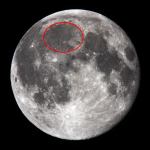 Sinus Iridum is a representative bay on the visible side of the moon, on the northwestern edge of Mare Imbrium (the Sea of Rains), whose location we pointed out in the photograph on the left, marked in red.
Sinus Iridum is a representative bay on the visible side of the moon, on the northwestern edge of Mare Imbrium (the Sea of Rains), whose location we pointed out in the photograph on the left, marked in red.
This is a vast mare, the second largest in the Moon, only surpassed in diameter by Mare Frigoris (The Sea of Cold ), which occupies as we see, much of the northwestern quadrant of the satellite. It is an accident easy to locate, since it is north of the well known Copernicus (see article on the Lunar Terminator), The Lord 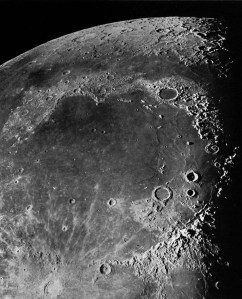 fo the Moon, with its distinctive radial system; in the northeast we find the dark circle of Plato. In the southeast is Archimedes, along with the smaller Aristillus and Autolycus (the Triple A) and Montes Apenninus and diametrically opposed to these, Sinus Iridum, purpose of this study. The dark rift that appears across the top of the photograph is Mare Frigoris.
fo the Moon, with its distinctive radial system; in the northeast we find the dark circle of Plato. In the southeast is Archimedes, along with the smaller Aristillus and Autolycus (the Triple A) and Montes Apenninus and diametrically opposed to these, Sinus Iridum, purpose of this study. The dark rift that appears across the top of the photograph is Mare Frigoris.
The whole area has the systematic dark color of the maria (seas, plural of mare), in contrast to the ostensibly brighter on the highlands surrounding the region except its western side.
LOCATION AND PHYSICAL CHARACTERISTICS
This is a extensive plain in the northwestern edge of Mare Imbrium, caused by the impact of a huge meteorite, which has a diameter of 236 km and represents one of the most 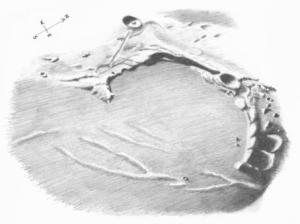 beautiful areas of the lunar landscape. The soil, filled with basaltic lava, is essentially flat, although it presents some irregularities in the form of slightly raised ridges, especially at the entrance to the Bay to the southeast, as illustrated in the drawing, although it is difficult to see them with an amateur telescope, and absent of significant craters.
beautiful areas of the lunar landscape. The soil, filled with basaltic lava, is essentially flat, although it presents some irregularities in the form of slightly raised ridges, especially at the entrance to the Bay to the southeast, as illustrated in the drawing, although it is difficult to see them with an amateur telescope, and absent of significant craters.
Sinus Iridum has its northwest boundary in the Montes Jura, a mountain so called in memory of the Jura Mountains in western Switzerland. 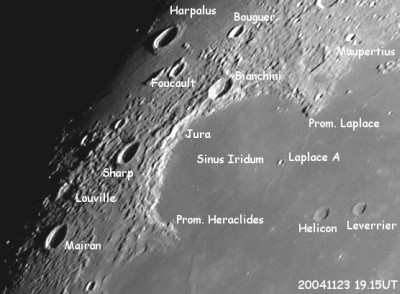 The ridge runs along the bay at the top, forming a half-ring of 350 km in length, beginning at the northeast corner of the Promontorium Laplace, and southwest by the Promontorium Heraclides
The ridge runs along the bay at the top, forming a half-ring of 350 km in length, beginning at the northeast corner of the Promontorium Laplace, and southwest by the Promontorium Heraclides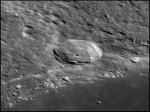 , which will be discussed below. The chain is interrupted by Bianchini (that we see in the picture on the left), an impact crater of 38 km in diameter and a depth of 3100 meters, 300 more than the altitude of the Aneto, the highest mountain in the Pyrenees. Bianchini presents ridges in its center, and some areas of its inner north wall have collapsed on the ground.
, which will be discussed below. The chain is interrupted by Bianchini (that we see in the picture on the left), an impact crater of 38 km in diameter and a depth of 3100 meters, 300 more than the altitude of the Aneto, the highest mountain in the Pyrenees. Bianchini presents ridges in its center, and some areas of its inner north wall have collapsed on the ground.
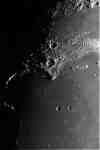 Promontorium Laplace, in the center of the image, closes the Bay in its northeastern end, and is a wonderful show at daybreak, with slanting light, 10 days after the new moon. Their altitudes above 3200 meters cast shadows on the floor of Sinus, which will be shortening as hours progress, and whose observation is indispensable. I’ve spent long hours observing eye glued to this accident that we will see below.
Promontorium Laplace, in the center of the image, closes the Bay in its northeastern end, and is a wonderful show at daybreak, with slanting light, 10 days after the new moon. Their altitudes above 3200 meters cast shadows on the floor of Sinus, which will be shortening as hours progress, and whose observation is indispensable. I’ve spent long hours observing eye glued to this accident that we will see below.
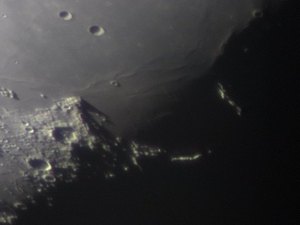
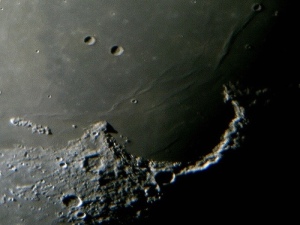
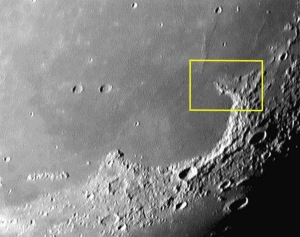
PROMONTORIUM HERACLIDES, THE MOON MAIDEN.
Around the eleventh day after the new moon with a crescent gibbous moon the dawn begins on the highest peaks of Promontorium Heraclides (Cape Heraclides). This is a cliff that overlooks the southwestern border of Sinus Iridum, from a height of 1,064 meters. As the terminator moves over the course of the hours we are going to see how it takes shape with the help of the shadows, one of the most fascinating figures of all selenography: The Moon Maiden. The ideal place to observe this great spectacle is the southern hemisphere, or else be aware that we observe it with a rotation of 180 degrees.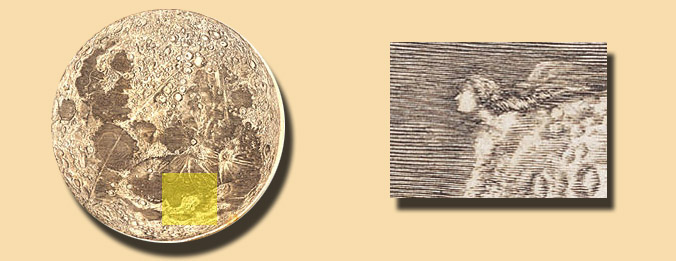 In 1679, Giovanni Cassini, was tasked, by King Louis XIV of France, to make a lunar map. In the area corresponding to Promontorium Heraclides, the engraver drew a woman’s head, we do not know if motu proprio or commissioned by Cassini himself.
In 1679, Giovanni Cassini, was tasked, by King Louis XIV of France, to make a lunar map. In the area corresponding to Promontorium Heraclides, the engraver drew a woman’s head, we do not know if motu proprio or commissioned by Cassini himself.
The Pleiades open cluster
Posted by: bitacoradegalileo on: July 21, 2011
WHAT ARE OPEN CLUSTERS?
Open clusters are groups of tens, hundreds or thousands of stars originated in the same cloud of gas. Often the gas is gone, in whole or in part, because the radiation emitted by the brightest stars and his appearance is that of an irregular splash of bright spots, with no general structure and asymmetric.
stars originated in the same cloud of gas. Often the gas is gone, in whole or in part, because the radiation emitted by the brightest stars and his appearance is that of an irregular splash of bright spots, with no general structure and asymmetric.

The hosted stars are generally young (a few hundred million years; compare with the 4,000 million of the Sun), massive and very hot.
They are scattered on sizes in the order of thirty light-years, and are slowly dispersed by the tidal effect produced by the center of the Milky Way, so that over time, -millions of years- the stars that form it will be mixing with the rest of the galaxy. Open clusters are also known by the name of galaxy clusters.
so that over time, -millions of years- the stars that form it will be mixing with the rest of the galaxy. Open clusters are also known by the name of galaxy clusters.
We bring here, as prominent examples, from top to bottom in this order, the Ptolemy’s Cluster in the constellation Scorpio, the spectacular double cluster in Perseus and the Manger (Praesepe in Latin), or the Beehive Cluster in Cancer.
But today we will focus on the beautiful Pleiades star cluster in the constellation of Taurus, which is undoubtedly the most famous, brilliant and beautiful of them all.
THE PLEIADES ARE IN TAURUS
 Taurus is the Zodiac constellation invented by the ancient Babylonians, whose Latin name (Taurus) means bull. Stands out in thewinter sky, between Aries to the west and Gemini to the east, its predecessor and successor in the Zodiac, respectively. To the north are Perseus and Auriga, Orion‘s southeast and to the southwest the constellation Eridanus river and Cetus, the Whale.
Taurus is the Zodiac constellation invented by the ancient Babylonians, whose Latin name (Taurus) means bull. Stands out in thewinter sky, between Aries to the west and Gemini to the east, its predecessor and successor in the Zodiac, respectively. To the north are Perseus and Auriga, Orion‘s southeast and to the southwest the constellation Eridanus river and Cetus, the Whale.

In this picture we see the night sky in the city of Buenos Aires (34 º S latitude, the same as Cape Town, South Africa), in the morning twilight of June 30th. All the stars that appear are in the ortho, ie, emerging from the eastern horizon, and their way to their transition to the north. Hamal, the main star of Aries, is the highest, while Gemini is still below the horizon. The inhabitants of the Northern Hemisphere will notice the position of Orion, just the opposite of how they normaly see it in their usual latitudes, as the stars representing the feet of the giant hunter, Rigel and Saiph are those which are higher, while Sirius and Aldebaran are at opposite positions as they are seen by the boreals. The Moon is in conjunction with the Pleiades, no strange thing, as will see.
The principal star of this constellation is Aldebaran (Alpha Tauri), a red-orange giant of magnitude +0.87, which is the thirteenth brightest from around the night sky, El Nath (Beta Tauri) or Al Nathis a blue-white giant of magnitude +1.68. In this constellation are famous, as well as the Pleiades, the Crab Nebula (M1), that we see on the right, and the Hyades, another open cluster in the same line of sight of Aldebaran, but this star is not part of the cluster,because it is located halfway.
a red-orange giant of magnitude +0.87, which is the thirteenth brightest from around the night sky, El Nath (Beta Tauri) or Al Nathis a blue-white giant of magnitude +1.68. In this constellation are famous, as well as the Pleiades, the Crab Nebula (M1), that we see on the right, and the Hyades, another open cluster in the same line of sight of Aldebaran, but this star is not part of the cluster,because it is located halfway.
The open cluster of the Pleiades (M45)
The Pleiades (Pigeons in Greek), is an object visible without optical aid, located at the side of the constellation Taurus. Receivesalso the name of Messier 45 or M45, as Charles Messier included it correspondingly numbered in his catalogue of disturbing objects in 1769. Other names that have been popular tradition are The Seven Sisters or The seven goats.
This is a group of stars, a total of approximately 500, very young (about 100 million years), which is located approximately 400 light-years away, this figure oscillates depending on the sources consulted. The cluster is about 12 light years in diameter, and occupies an angle of about 110 minutes of arc in the sky, equivalent to nearly four times the Full Moon,
The cluster is about 12 light years in diameter, and occupies an angle of about 110 minutes of arc in the sky, equivalent to nearly four times the Full Moon,  starring frequent conjunctions with it, as shown on the left, as well as with the other planets in the Solar System, because it is located at is only 5 ° from the ecliptic (the line describing the moon and all planets in its orbit).
starring frequent conjunctions with it, as shown on the left, as well as with the other planets in the Solar System, because it is located at is only 5 ° from the ecliptic (the line describing the moon and all planets in its orbit).  This circumstance produces beautiful effects of rapprochement between the stars, which are used by enthusiasts ofastrophotography. To the right the Pleaides are in conjunction with Venus.
This circumstance produces beautiful effects of rapprochement between the stars, which are used by enthusiasts ofastrophotography. To the right the Pleaides are in conjunction with Venus.
The brightest stars in the cluster are blue-white color and have a size equivalent to five times the Sun.

The principal stars are Alcyone (magnitude 2.87), Atlas (3.63), Electra (3.7), Maia (3.87), Merope (4.18), Taygeta (4.3), Pleione (5.09), Celaeno (5.46), Tau 18 (5.64), Asterope I (5.76) and Asterope II (6.43).
The cluster is surrounded by a nebula, which becomes more evident in the proximity of the brightest stars, and reaches its greatest prominence wrapping Merope, a fact which has important consequences in the mythology around this beautiful cluster, as we will see. The cluster stars split gradually, and it is estimated that within 250 millions of years will not exist as such, separating and becoming individual stars (or multiple if applicable).
HISTORY AND MYTHOLOGY
The Pleiades are mentioned in the Mahabharata, the Iliad and the Odyssey of Homer, and three times in the Bible. They form the basis of the Mayan calendar, to whose tradition they are 400 warriors whose souls were put into the sky after being killed by the arrogant Zipacna.
 For the classical Hellenistic tradition, the Pleiades are the seven daughters of Atlas and Pleione, sisters among others of the Hyades which, after being persecuted for years by the giant Orion, appealed for help to Zeus, who turned them into pigeons, after which they rested on the back of the Bull (Taurus constellation), which thus constituted the guardian of the sisters. Merope, embarrassed after being raped by the giant, is hidden behind its own nebula.
For the classical Hellenistic tradition, the Pleiades are the seven daughters of Atlas and Pleione, sisters among others of the Hyades which, after being persecuted for years by the giant Orion, appealed for help to Zeus, who turned them into pigeons, after which they rested on the back of the Bull (Taurus constellation), which thus constituted the guardian of the sisters. Merope, embarrassed after being raped by the giant, is hidden behind its own nebula.
Orion, the Cathedral of the Sky
Posted by: bitacoradegalileo on: July 19, 2011
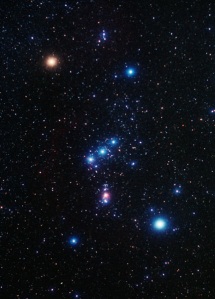 Orion is undoubtedly the most famous constellation in the sky of winter, and one of the best known among the 88 currently recognized by the IAU (International Astronomical Union). Its bright stars visible from both hemispheres make this constellation globally recognized and in my opinion the most fascinating. It has been called “The Cathedral of Heaven“, a name which I subscribe enthusiastically.
Orion is undoubtedly the most famous constellation in the sky of winter, and one of the best known among the 88 currently recognized by the IAU (International Astronomical Union). Its bright stars visible from both hemispheres make this constellation globally recognized and in my opinion the most fascinating. It has been called “The Cathedral of Heaven“, a name which I subscribe enthusiastically.
It is located right in the middle of the celestial equator, and is used as a reference for others, as we shall see. Orion resembles a person. First, try to locate the belt of Orion,  which consists of three bright stars in a straight line (Alnitak, Alnilam and Mintaka, from left to right). One of his legs is represented by a bright star called Rigel, which is one of thebrightest stars in the night sky. The other leg corresponds to the star Saiph. His two shoulders are the stars Bellatrix and Betelgeuse.
which consists of three bright stars in a straight line (Alnitak, Alnilam and Mintaka, from left to right). One of his legs is represented by a bright star called Rigel, which is one of thebrightest stars in the night sky. The other leg corresponds to the star Saiph. His two shoulders are the stars Bellatrix and Betelgeuse.  This last one is so bright that you can see its reddish color without the help of telescopes or binoculars, just the naked eye. A fainter star, Meissen, corresponds to the head. The whole is identified with the myth of the giant Orion, the hunter.
This last one is so bright that you can see its reddish color without the help of telescopes or binoculars, just the naked eye. A fainter star, Meissen, corresponds to the head. The whole is identified with the myth of the giant Orion, the hunter.
The other stars of the constellation with proper name are Tabit (the shield), and Hatysa (the sword), also called Nair Al Saiph.
MAIN STARS
The brightest stars of the constellation are Rigel, Betelgeuse, Bellatrix, Alnilam, Alnitak,Saiph, Mintaka and Hatysa, in that order. These stars are at different distances from us,and their form in space is only a flat projection, which from another point of view would appear quite different, ruining all the rivers of ink spilled about the shape the constellation.
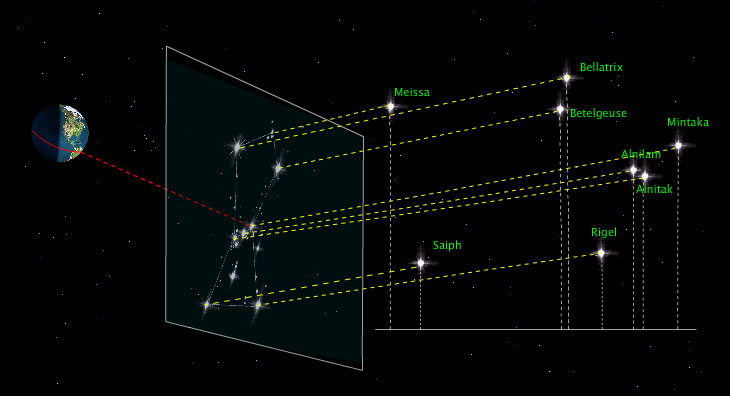
We will stop briefly at each of these luminaries:
Rigel is the star Beta Orionis. Although its designation of Bayer “Beta” should correspond to the second brightest star in the constellation, its apparent magnitude of+0.18 indeed places it as the brightest of it ahead of Betelgeuse 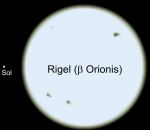 (Alpha Orionis) being the fifth brightest all over the night sky. According to estimates by Hipparcos satellite , its distance from the Sun is about 860 light-years. This is a triple star system whose main component is a blue-white supergiant with a surface temperature of 11,500 ° K. Glows with a brightness in the visible spectrum over 50,000 times of the Sun’s and of 85,000 suns in bolometric scale. Its radius is equal to 84 times our star, so if it were in the place of the Sun, it would extend to the orbit of Mercury.
(Alpha Orionis) being the fifth brightest all over the night sky. According to estimates by Hipparcos satellite , its distance from the Sun is about 860 light-years. This is a triple star system whose main component is a blue-white supergiant with a surface temperature of 11,500 ° K. Glows with a brightness in the visible spectrum over 50,000 times of the Sun’s and of 85,000 suns in bolometric scale. Its radius is equal to 84 times our star, so if it were in the place of the Sun, it would extend to the orbit of Mercury.
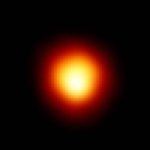 Betelgeuse, also called Alpha Orionis, is a beautiful red star, the ninth brightest in the sky, big and bright, for it is a red supergiant. The characteristic color of this star comes from the lowsurface temperatures, 3,000 ° K. It is a variable star, and its maximum size would extendbeyond the orbit of Mars. It is about 800 times larger than the Sun. It is located about 650 light years from the Solar System and its visual magnitude is between +0.5 and+1.3.
Betelgeuse, also called Alpha Orionis, is a beautiful red star, the ninth brightest in the sky, big and bright, for it is a red supergiant. The characteristic color of this star comes from the lowsurface temperatures, 3,000 ° K. It is a variable star, and its maximum size would extendbeyond the orbit of Mars. It is about 800 times larger than the Sun. It is located about 650 light years from the Solar System and its visual magnitude is between +0.5 and+1.3.
Bellatrix (Gamma Orionis) is the third brightest star in the constellation, with apparent magnitude +1.64. Bellatrix’s name, the Amazon Star, comes from Latin and means “warrior.” It is a blue giant with a surface temperature of 21,500 K, one of the hottest stars you can see at a glance. It is6400 times brighter than our Sun, and 5.7 times larger than this. It is situated about 250light years from us.
Alnilam (Epsilon Orionis) is, with apparent magnitude +1.7, the fourth brightest star in Orion. This is the central star of the Belt, and the brightest of the three, despite being the farthest, about 1340 years-years away. It is a blue supergiant, whose brightness is extraordinary, equivalent to about 375,000 times the luminosity of the Sun. Alnilam is very hot, about 25,000 K and its diameter is 31 times the Sun’s.
Alnitak (Zeta Orionis) is a triple star system also part of Orion’s Belt. The main component is a blue supergiantof apparent magnitude +1.89, located about 800 light-years from Earth. It is very hot,about 31,000 K, and its mass is estimated at about 20 solar masses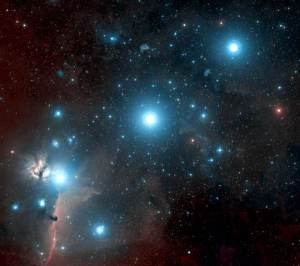 .
.
Saiph (Kappa Orionis) is the sixth brightest. Has a magnitude of +2.06 and is located about 720 light-years away. With a surface temperature of 26,000 K, is a blue supergiant with a radius 11times the solar radio.
Mintaka (Delta Orionis) is the third of the stars in the Belt, and the faintest of them, with a magnitude of +2.23jointly, because it is a complex multiple star. It is is a blue star at 915 light years and has a temperature of 30,000 ° K. Its mass is equivalent to 20 suns.
Hatysa (Iota Orionis) is found in the Sword of Orion, and with a magnitude of +2.75 is the brightest of which make said sword. Also known as Na’ir to Saif. No one knows the distance that it is located, speculating with numbers ranging from 1300 to 2000 light-years away. It is a blue giant that is 31,500 ° K temperature, i.e. more than 25,000 K hotter than the Sun. Its mass is equal to 15 times our star.
M42: THE GREAT NEBULA IN ORION.
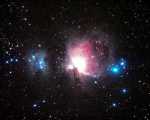
In the center of the Sword of Orion, below the belt is distinguished, with the naked eye, adiffuse spot sometimes confused with a star. It is the object of Charles Messier’s catalog number 42, M42, known as the Great Nebula of Orion. It is a diffuse nebula, one of the brightest that exist, which can be seen without optical aid. Located around 1,500 light years from us, has a diameter of about 30 light-years. At first sight appears blurry, but with simple telescopes, or simply with binoculars it can be seen quite clearly . Optical images show that this is a huge cloud of gas and dust. Contains within newly formed stars, interstellar clouds, star clusters, H II regions Hydrogen (ionically active) and reflection nebulae. The little cloud that appears torn at the top is the De Marian’s nebula , or M43. Several factions of the nebula have their own name. The dark path that extends from the north to the bright region called the Fish’s Mouth, and the light regionson both sides are called Wings.
. Optical images show that this is a huge cloud of gas and dust. Contains within newly formed stars, interstellar clouds, star clusters, H II regions Hydrogen (ionically active) and reflection nebulae. The little cloud that appears torn at the top is the De Marian’s nebula , or M43. Several factions of the nebula have their own name. The dark path that extends from the north to the bright region called the Fish’s Mouth, and the light regionson both sides are called Wings.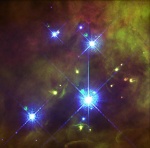
In this picture we see the Trapezium cluster, named for the asterism of its four main stars. These stars, between 5th and 9th magnitude, can be solved easily with a telescope of 80 mm opening. They are very young stars, just formed.
REGION ALNITAK

Alnitak (Zeta Orionis) is, may not be amiss to remember, the star to the left on the Belt of Orion. In the vicinity are two interesting deep sky objects: the Flame Nebula and Horsehead Nebula. The photograph shows Alnitak, the brightest star, and just below is the Flame Nebula, which gets its name from its appearance of being on fire.The bright star located at the top right is Sigma Orionis
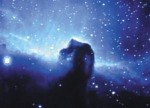 (doesn’t have a proper name), and at the center is the Horsehead, a spectacular dark nebula of which, on the left, we provide a detail.
(doesn’t have a proper name), and at the center is the Horsehead, a spectacular dark nebula of which, on the left, we provide a detail.
The Great Nebula in Orion is a very popular object for amateur astrophotographers. It takes an apparent extension in the sky of over 60′ of arc.
The Constellation of Orion and Sirius.
In the following paragraphs we will use the stars of the constellation Orion, already known, to locate other significant stars and constellations in the night sky in the winter,southern summer. We will do this using graphics that reproduce quite accurately the situation, regarding our constellation, of the stars that we are going to find. We will do this by drawing an imaginary line from Orion to the star in question.
This first scheme recreates the picture above, and shows how,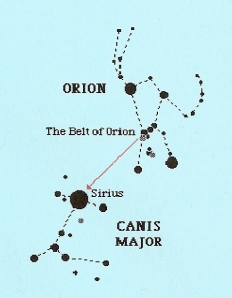 extending to the left the line connecting the three belt stars, we come easily to the proximity of Sirius (Alpha Canis Maioris), which is the brightest star in the entire night sky, then there will be no difficulty in locating the rest of the components of Canis Maior (Greater Dog). The inhabitants of the Southern Hemisphere should be aware that his view differs from the Boreal by 180 °.
extending to the left the line connecting the three belt stars, we come easily to the proximity of Sirius (Alpha Canis Maioris), which is the brightest star in the entire night sky, then there will be no difficulty in locating the rest of the components of Canis Maior (Greater Dog). The inhabitants of the Southern Hemisphere should be aware that his view differs from the Boreal by 180 °.

In this one, we have treated the scheme just the opposite, joining the line of three stars in the belt extending towards the right, just to the vicinity of Aldebaran (Alpha Tauri), a beautiful red giant star which is the principal in the constellation Taurus. A little further we appreciate the open star cluster M45, the magnificent Pleiades, which will be our next work. With regard to the Southern Hemisphere, we must make the same observation we made at the time of the previous scheme.
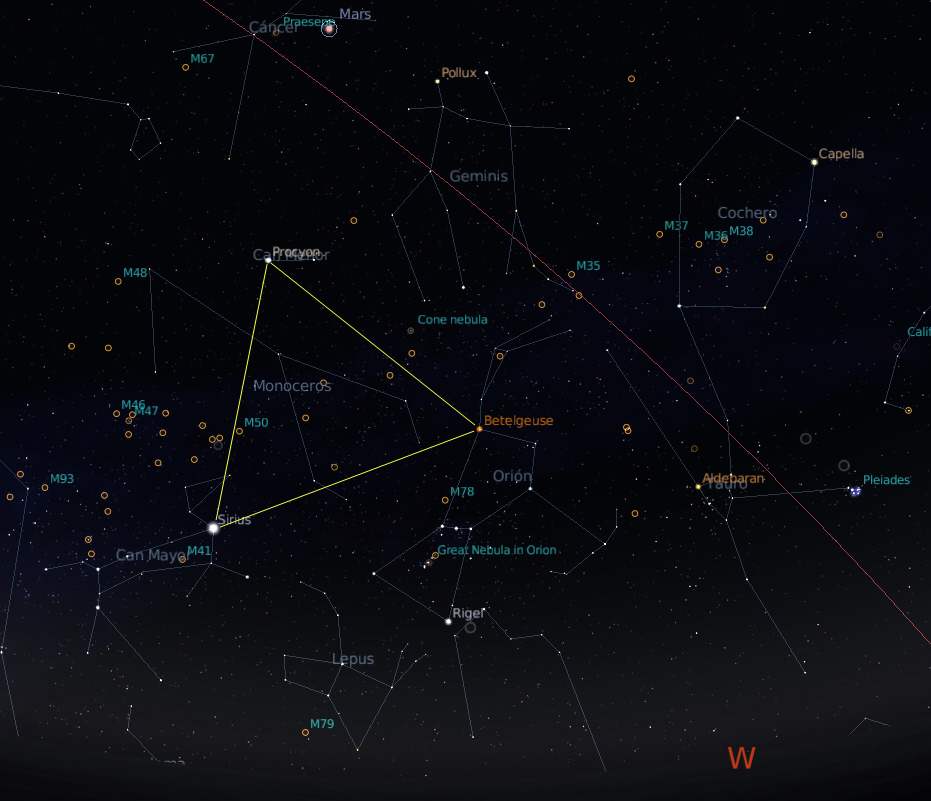 Finally, inasmuch as we already know the location of Betelgeuse, and have just learned to locate Sirius, we will use these two stars in the sky to build an imaginary equilateral triangle, that is called the Winter Triangle, whose third vertex will be Procyon , a very brilliant star, which is the main member of the constellation of Canis Minor (the Lesser Dog). There is also a Summer Triangleformed by Vega, Altair and Deneb.
Finally, inasmuch as we already know the location of Betelgeuse, and have just learned to locate Sirius, we will use these two stars in the sky to build an imaginary equilateral triangle, that is called the Winter Triangle, whose third vertex will be Procyon , a very brilliant star, which is the main member of the constellation of Canis Minor (the Lesser Dog). There is also a Summer Triangleformed by Vega, Altair and Deneb.
Using these and other little tricks, we can go gradually placing the constellations and principal stars, thereby increasing our knowledge of Heaven and Outer Space without effort, but with love and dedication.
MYTHOLOGY
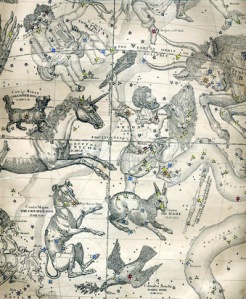
Orion was the son of Poseidon, god of the sea, and Gaia, Mother Earth. He had an extraordinary beauty and grew so much that became a genuine giant. So enormous he was he could walk along the bottom of the deep sea waters without ever cover him from the shoulders up.
After many adventures, Orion went to the island of Chios, where soon later fell in love with Merope, the daughter of King Oenopion. Such was his love for her that sought her in marriage. Oenopion consented, but first demanded the giant to prove his courageperforming a difficult mission. Orion would have to kill a large number of pests that were causing huge losses to crops on the island. When he had exterminated all the vermin, the monarch refused to keep his promise.
Orion tried to take revenge on Oenopion, but could not find him because he took refuge in a subterranean chamber so convoluted,that it was practically Inscrutable. Then, Orion set up even more in anger and, in rage, he felt like killing with his infallible arrows and mercilessly all the animals that were going out to meet, whether gentle or fierce animals and innocent creatures. Such was the number of casualties he had caused already that his mother Gea had to intervene asking, without success, that he was kind and thoughtful. Orion ignored the words of his mother and sticked to his guns, despite the repeated warnings from Gea.
One day, when the proud giant was meeting with friends, conceited that neither tigers or panthers, or even lions or snakes were able to produce any awe, overwhelmed the patience of his mother, who sent a very poisonous scorpion. Orion, when he saw it,was unable to contain his ironic smile at the ridiculousness of this insignificant adversary sent by Gaia.
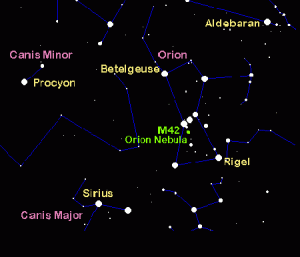 The giant relied too much and the scorpion stung him in the foot with its powerful poisonous sting. The terrible venom spread through the blood of the hunter and he fell down half dying. When he saw that death was imminent, asked for help and beggedZeus almighty for vengeance, as death was stalking him ingloriously for a character in his mood. He asked the supreme God toput him in heaven with his two faithful hunting dogs (Canis Major and Canis Minor) and a hare (Lepus), so that, when men look upin the dark starry nights, remember his adventures as a hunter. Also requested Zeus the domain of tempests, storms, ice and winds, to be able to take avenge on his mother Earth (Gaia).
The giant relied too much and the scorpion stung him in the foot with its powerful poisonous sting. The terrible venom spread through the blood of the hunter and he fell down half dying. When he saw that death was imminent, asked for help and beggedZeus almighty for vengeance, as death was stalking him ingloriously for a character in his mood. He asked the supreme God toput him in heaven with his two faithful hunting dogs (Canis Major and Canis Minor) and a hare (Lepus), so that, when men look upin the dark starry nights, remember his adventures as a hunter. Also requested Zeus the domain of tempests, storms, ice and winds, to be able to take avenge on his mother Earth (Gaia).
The god was condescending with Orion and his supplications were attended. The earth trembled, and since then it has been doing to this day every time Orion has been seen above the firmament, as he has always brought the wind, the cold, the storms, the ice, the snow and the frost which are so abundant on Earth in winter, coinciding with the arrival of this constellation.
Zeus was also responsible of placing the Scorpion (Scorpius) in the sky, but was careful to place it as far away from the giant so they would never ever face. So, when Orion disappears from the sky it is when Scorpius appears. While Orion appears in winterScorpius does in the summer.
ORION IN THE HISTORY OF CIVILIZATIONS
The Egyptians saw the constellation Orion as the god Osiris holding in his hands the star Aldebaran, or Alpha Tauri.
Isis is represented as the star Sirius, the brightest in the sky and that we see in the skies from November through March. To the Egyptians their calendar began when they observed Sirius in its output or rising shortly before sunrise, a phenomenon that occurred in June and by the precession of the equinoxes is now produced in late August and involved the flooding of the Nile, fundamental for the control and development of Egyptian civilization.
 Some fragments of the Pyramid Texts say that the soul of Pharaoh would become a star in Orion:
Some fragments of the Pyramid Texts say that the soul of Pharaoh would become a star in Orion:
“In your name of Inhabitant of Orion, a season in heaven and a season on earth”
(Pyramid Texts 187).
“Oh king, you’re the great star, the companion of Orion, who runs through the sky with Orion, you navigate the Duat [underworld] withOsiris, thou ascend from the eastern sky being renewed in your due time and rejuvenated your due time. The heaven has beenwith Orion”
(Pyramid Texts 882-3).
In the book of the Bible, Orion is mentioned at least three times, two of them in the Book of Job.
“He is the maker of the Bear, Orion, and the Pleiades, And the chambers of the south”, Job 9:9.
“Can you bind the chains of the Pleiades or loose the cords of Orion?”, Job 38:31.
And in the Book of Amos 5:8.
Especially in the modern age, through technological creation humanity has been able to see great detail in the sky. Thus, the Hubble Space Telescope, Astronomical Eye Site, its creators have received wonderful scenes like the Orion Nebula or the Horsehead Nebula.
The following illustration is taken from the book “The Orion Mystery” by Adrian Gilbert. The picture depicts a scene in which “the Messenger” gets a ray from the “Portal” of Gemini while St. John wrote the Book of Revelation.
“Opening of the Stargate: 29th June AD 2000″ .
Painting by Bengt Alfredson.
ORIENTATION OF THE ASTRONOMICAL OBSERVATORY IN THE SOUTHERN HEMISPHERE
Posted by: bitacoradegalileo on: July 17, 2011
I get to write with the intention of trying to explain how affects the direction of an observatory in the contemplation of heaven to the naked eye or with optical instruments such as binoculars or telescopes.
To do this, we must first consider what is the behavior of the apparent motion of the heavenly bodies and how they evolve and end their journey. We know that the Sun, the most prominent object in the sky, rises from the east, gets higher in the sky up to its maximum in the North, which also receives the name of midday, and then begins to descend, until it dies in the western horizon.
We also know that this movement of the sun is not so, but actually an optical illusioncaused by the Earth’s rotation around its own axis, completing one full revolution every 24 hours, period which we have agreed to call “day.”
But the Sun is not the only one who suffers the effects of Earth’s rotation, but ALL of theheavenly bodies, except for the circumpolar constellations, revolving around the South Celestial Pole, and due to their proximity to it, never disappear below the horizon.
All the other stars “come out” from the east, reach their highest altitude in the North and”die” or put in the west. This includes the moon and all planets of the Solar System.
The immediate consequence of this is that the stars are most clearly seen in the North, which is where they reach their maximum altitude above the horizon, and therefore avoid air pollution and obstacles in our line of sight, away from the possible sources of light pollution by mercury and sodium vapor streetlights of the public and other light sources in the neighborhood.
There is a but to this general rule: there are many stars that reach their maximum altitudes upon us, which really becomes uncomfortable, it is not easy to observe for a held while the stars that lie just above our heads . With certain types of telescopes (known as refractors), observation is really cumbersome.
That’s why so many amateurs, myself included, prefer watching halfway between the rising of the star in question (the East) and their transit or culmination (the North), a fact that occurs in about the Northeast, making this point, therefore, ideal for the study and enjoyment of the wonders of our sky.
THE LUNAR TERMINATOR
Posted by: admin on: July 16, 2011
- In: Moon
- Leave a Comment
Today we write an explanation of the meaning of “lunar terminator”. I searched the internet and not fully satisfied me anything I found. So I accepted the challenge to explain it myself, with some graphic support, to help understand it better.
It is well known that the moon, the beautiful heavenly body that serves us as companion day and night, though many think it is only at night, as I say that everyone knows has phases. This means that the surface that shows illuminated by the Sun, because that is the source of its brilliance, is changing every day, even every moment, showing almost always (except full moon) one portion illuminated and another dark separated by a line that marks the division between selenite day and night: The lunar terminator. This line, of course, is constantly changing its location, and it is where the sunlight is flush and an observer on the moon’s surface at that point would see the sun on the horizon. The terminator has two ends, north and south, called cusps.
It  is important to notice, and it can be seen in the photograph, how it is along the terminator where we can see the shadows reveal the depth of the crater walls and the height of the mountain ranges. Looking at the Northern Hemisphere, we see a crater, just above the terminator, which is the large crater Plato (101 km in diameter and walls 2400 meters high) below Archimedes (55 km and 1850 m), almost in darkness and then a mountain range, almost straight, near the landing site of Apollo XV, which is called Montes Apenninus, in memory of its namesake mountain range in Italy. This ends, at its western end, in the crater Eratosthenes (60 km and 3150 m), a resident of the great Copernicus (90 km and 3900 m), “The Lord of the Moon” with its radial system of ejecta at the time impact. Well, we see how Copernicus receives sunlight more perpendicular than the other craters near the terminator, and we cannot appreciate it’s depth, though it exceeds the highest point in Spain, Mount Teide in Tenerife (3718 m above sea level).
is important to notice, and it can be seen in the photograph, how it is along the terminator where we can see the shadows reveal the depth of the crater walls and the height of the mountain ranges. Looking at the Northern Hemisphere, we see a crater, just above the terminator, which is the large crater Plato (101 km in diameter and walls 2400 meters high) below Archimedes (55 km and 1850 m), almost in darkness and then a mountain range, almost straight, near the landing site of Apollo XV, which is called Montes Apenninus, in memory of its namesake mountain range in Italy. This ends, at its western end, in the crater Eratosthenes (60 km and 3150 m), a resident of the great Copernicus (90 km and 3900 m), “The Lord of the Moon” with its radial system of ejecta at the time impact. Well, we see how Copernicus receives sunlight more perpendicular than the other craters near the terminator, and we cannot appreciate it’s depth, though it exceeds the highest point in Spain, Mount Teide in Tenerife (3718 m above sea level).
The rest of the illuminated surface on the moon, further from our line, it seems to us almost flat, without being, because of the effect described in the perpendicularity of the sun and the absence of shadows.
It is easily understood that when the moon is fully illuminated (the full moon phase), there is no terminator, and we can not take advantage of this inclination of the sun for optimal observation. That’s why astronomers, against the belief of the majority, avoid this stage that only poses problems to the observer. When studying deep-sky objects, the full moon works as a huge spotlight installed in the sky that dazzles and prevents the vision of lower luminosity objects such as star clusters, nebulae and distant galaxies. If we want to study the moon, the perpendicularity of the rays also greatly complicates the study, revealing even necessary to use a moon filter (a light green or yellow would be appropriate) to avoid damage to our eyes producing a prolonged observation (The reflecting light of the full moon is 12 times higher than it radiates at waxing or waning crescent).
I know amateurs who keep their astronomical equipment in such situations and use them again only when the moon decreases the intensity of its brightness. Definitely, these guys aren’t werewolves nor are in love, because they really do appreciate the full moon.
A couple of definitions alien to me:
WIKIPEDIA: The Lunar terminator is the division between the illuminated and dark parts of the Earth’s Moon.
Elcielodelmes.com: The area bordering the light and shadow is called the terminator.
One last example to end:
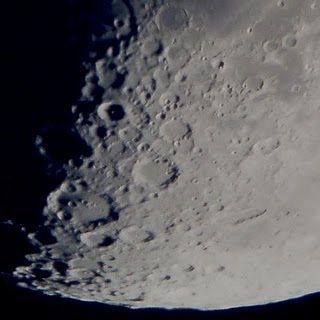
South Moon photography, one of the most rugged. Being close to the terminator, the craters can be seen in all its splendor.
Anyway, that’s all. I did not want to do a superficial, long and tedious outline with excessive technical details, less interesting, nor a walk too shallow not to allow to understand the meaning and importance of the lunar terminator, that ally helping us in contemplation, study and enjoy of our beautiful satellite. I hope this small contribution is helpful.
May you have clear skies and happy observations.






